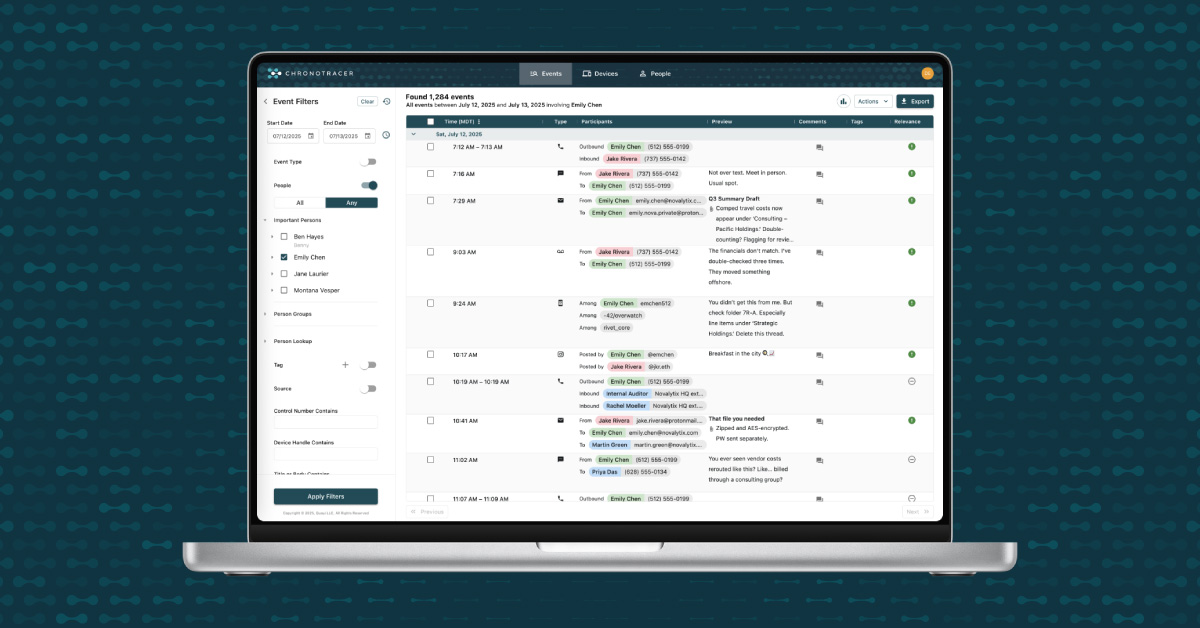By Richard Gorelick, Founder and CEO, ChronoTracer
In the middle of a high-stakes legal crisis in 2020, I saw something that didn’t make sense.
I was helping two close friends with a critical legal matter. One was facing a serious (but legally and factually dubious) FCPA charge; the other was his defense counsel. They’d asked me to be involved as an advisor.
The defense team included a litigation boutique, a mid-size regional firm and an AmLaw 20 firm, all working together and reviewing evidence using a leading e-discovery platform. So when I saw them manually cobbling together case chronologies from phone bills, emails, print-outs of text messages, video-conferencing logs, and more, I was stunned. Hundreds of hours of expensive legal time were going into a process that felt like cut-and-paste archaeology.
Surely, I asked, isn’t there software that could extract communications and other facts from this evidence and automatically assemble a usable chronology?
There wasn’t.
I asked everyone I could think of—including the head of eDiscovery at the AmLaw 20 firm, who told me that if we could build what I envisioned – a “single pane of glass” – a unified view – through which to view all the different types of evidence in order and in context – it would be the “holy grail.”
That was the pull I needed.
I teamed up with Dexter Weiss, a brilliant developer introduced to me by two former business partners. We had initially been exploring a different project, but once we saw the scale of this problem in the legal market, we knew we had to build something better.
We called it ChronoTracer.
By early 2021, our first version of the product was being used by that original defense team. It worked: it helped them track events across vast volumes of communication evidence, organize the facts by participant and time, and iterate queries easily when the legal needs evolved. No more static spreadsheets. No more starting over every time the scope of inquiry changed.
For a couple of years, ChronoTracer remained a powerful and interesting side project for me and Dexter. We were waiting for that initial FCPA case to go to trial. But after a series of delays, when the trial got postponed again in late 2023, I emailed some of the users and asked if they had any other matters that ChronoTracer could support. Within minutes, I received a call from the AmLaw 20 firm.
They had a high profile public corruption case involving millions of phone calls, text messages and emails that was expected to head to trial within months.
Soon, ChronoTracer was being deployed across over 20 million documents in a case involving multiple defense firms. It tested every aspect of our platform’s scalability and proved just how desperately litigation teams needed a better way to make sense of complex digital evidence.
ChronoTracer has now been used in a range of other matters: a state RICO case, a large-scale civil dispute, an internal investigation and cases with complex fact patterns involving millions of events. Along the way, we’ve received feedback from lawyers who told us flat out: “We couldn’t have done this case without ChronoTracer.”
That’s exactly what we built it for.
ChronoTracer is about putting the evidence in order and in context. It’s about helping teams move faster, understand their facts sooner, and preserve the story as it evolves.
I got into legal tech in the late 1990s when, as a young associate at a big law firm, I asked for internet access on my desktop and got rewarded (punished?) with a stint on my firm’s tech committee. More than 25 years later, I’m still asking the same kinds of questions: How can lawyers use technology to work smarter?
ChronoTracer is my answer.
